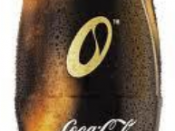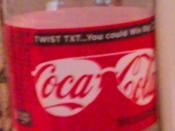Method 1)
Take a "volume" measuring device, and fill it with the total amount of water, the bottle can hold.
We then put the same, empty bottle into the container, in a way, that it sinks to the bottom of the akwarium. We can then measure the new height and multiply it by the volume of the liquid.
This will clearly give us the volume of a bottle.
Method 2)
We could pour water into a 0,5 litre coke bottle, and weigh how much it would weigh.
We could do the same thing with an empty bottle. The difference of the two would give
us the weight of the water. This way we could easily calculate the voulume of the bottle,
as we all know, that the volume of the liquid given on the label could be pretty much
the same as the volume of the bottle. If the bottle is plastic, then there is not that
much of a difference.
On the other hand, a glas bottle is much thicker, and would
have a slightly different volume.
If 1centimeter3 = 1 gram,
then (in this case) 500 centimeters3 would give us 500 grams.
From this we can see that the water weighs around 500 grams, and so this way, the volume
of the bottle would be around 500centimeters3 with a few decimal places (if we want to be accurate)
Method 3)
This is the last method, and the only sensible one that I could possibly think of. It is a method that could be taken under consideration, but I strongly feel, that it would be not as accurate as the earlier ones.
If the radius of the bottle = 2,5 cm.
And the height of the bottle = 15,3 cm,
Then:
Pi r2 h = volume of cylinder
(Pi 2,5 squared x 15,3)
.'. Volume = 300,3 cm3
The first two shapes could be trapeziums. The two circle segments on the side and the triangles down at the bottom should also be taken under consideration, as they clearly have an impact on the shape of the bottle.
In order to calculate the volume of the bottle accurately, I used easy methods that were straight to the point. This way, I knew that they will bring you pleasing results.
I tried to avoid difficult calculations, as they would confuse me, and could possibly mess up the results. I am being objective in what I am doing. To be honest, it is very difficult to calculate the volume of a bottle, using very advanced methods. I couldn't come up with any different
methods, as in my opinion, comparing water sources is a very good way to solve this problem. If I were to do any further, more in depth calculations, I would certainly
give my answers in decimal places, to one significant figure. This way, as we have all experienced in class we would get the most accurate answer.
I have serious doubts about method number 3, as I am sure that it is not as accurate as the other methods. We could not possibly measure the different shapes and compare it to the uneven curves inside the bottle. I only brought up the idea, as it is a good way to compare and analyze the different factors affecting the shape of the bottle. These are also the things that keep me from getting as accurate volume as possible. The weird dimensions and uneven shapes of the bottle strictly limit us from calculating the perfect volume.
I could check my results in a very simple way: by employing my ideas into real life. I could easily carry out my methods in setting up experiments to see whether my work is promising and carried out carefully with extra thought. I could possibly carry out the experiments for the each method a few times, in order to take the average of the given data. For example my idea about the water changing height, could bring different results. If I would notate similar results, then I could be certain about the accuracy of my calculations and methods.
I have chosen the three methods, as I strongly believe that they are quite complex, and in a way trustable. Giving the volume of the water in liters, comparing it with the bottle and then transferring it into centimeters3, in my opinion, brings trustable and satisfying results. Also water measuring devices with given measuring scales, are a good way to accomplish pleasing results.
I think that the benefit of my methods, is that they are easily manageable, and could be used in everyday life, without any necessary difficulties.
On the other hand, we could also consider other situations, like bottles with simple shapes. Without any greater problems, we could calculate the volume, just by calculating each shape of the bottle separately, and in the end, adding it all together in a total. This method is quite useful to show how different bottles change our way of understanding things. When calculating the volume of a simple bottle, we have many ideas that are straight to the point. With different bottles, we have to take under consideration every thought and idea, which not necessarily always has to be right.
The results if my investigation can be considered as pleasing I have used some reliable methods and less ones. There are many ways of finding out the volume of a bottle, although not every bring common results. I consulted some friends of mine, and tried to compare my methods. Some of them were similar, but some of them I consider better ones than mine. I tried to come up with some methods of my own in order to avoid repetition. At one point I read some methods of others and came up with reasonable solutions. For example melting a bottle into a sphere or other useful shape wouldn't be a good idea, as most of the value of the volume would be simply lost. This would happen as the bottle is empty.
I used Archimedes's theory in my investigation to calculate the volume of the bottle, as this was a reliable source to look at. He stated, that a body, sinked in water, would oust the same volume as the mass has.
As I mentioned before, the first two methods are rather reliable, but the 3rd one brings doubts along.
I am satisfied in a way, that my investigation proceeded accordingly to my plans. There weren't any noticeable problems faced.
I am happy to say that this was a fair investigation.


